Download Pdf [2,32 MB] - MTU Aero Engines
Download Pdf [2,32 MB] - MTU Aero Engines
Download Pdf [2,32 MB] - MTU Aero Engines
You also want an ePaper? Increase the reach of your titles
YUMPU automatically turns print PDFs into web optimized ePapers that Google loves.
Cover Story<br />
Inspecting the compressor before its first test run at <strong>MTU</strong>.<br />
key to the efficient operation of a geared turbofan,”<br />
he adds. The first run is slated for<br />
end-2007. After further ground tests, the<br />
geared turbofan is expected to fly in 2008.<br />
The flight tests will involve a retrofitted A340<br />
and a B747. The tests aim to demonstrate<br />
the production maturity of the concept and<br />
convince aircraft manufacturers and airlines<br />
of the desirability of the innovative engine.<br />
Sharp increases in fuel prices may prove<br />
another argument in favor of the new fuelthrifty<br />
technology.<br />
<strong>MTU</strong> and Pratt & Whitney are moreover developing<br />
a new commercial high-pressure compressor.<br />
This is a somewhat unusual project,<br />
the interface between the partners running<br />
midway through the compressor: <strong>MTU</strong> is<br />
responsible for the first four stages and Pratt<br />
& Whitney for stages five to eight. “Split production<br />
of that type works only in a good and<br />
trusted spirit of cooperation,” Winkler says.<br />
The advantage afforded by the new approach<br />
is that either partner can leverage its respec-<br />
tive traditional expertise: “The new high-pressure<br />
compressor is part of the fourth engine<br />
generation and a consistent upgrade of its<br />
predecessors.”<br />
<strong>MTU</strong> upgraded its compressor test stand for the particular test requirements.<br />
The eight-stage, highly efficient compressor<br />
has an extremely high, 17:1 compression<br />
ratio. Its blisk construction and positively<br />
coupled rotor disks make it extremely light-<br />
Light-weight and efficient: the high-pressure compressor<br />
features blisk construction and a novel interlocking<br />
rotor disk arrangement.<br />
weight. The latest sibling of the <strong>MTU</strong> compressor<br />
family might prove a capable centerpiece<br />
for the next engine generation. It is a<br />
versatile candidate that apart from its use in<br />
the geared turbofan might find applications<br />
also in conventional turbofans. Already, it<br />
has successfully completed its first trials:<br />
this spring, the compressor went to a test<br />
cell at <strong>MTU</strong>’s Munich facility, where it was<br />
tested in terms of efficiency, robustness and<br />
structural mechanics. <strong>MTU</strong> is responsible for<br />
the entire testing of the component and has<br />
its test cell specifically upgraded for it.<br />
Higher input powers make the test cell especially<br />
capable. More test lanes and higher<br />
scanning rates permit detailed measurements<br />
to be made. A new feature is that it<br />
enables non-contact vibration monitoring to<br />
be conducted of all rotor blades of the eight<br />
stages.<br />
“The geared turbofan demonstrator and<br />
high-pressure compressor put us in a technically<br />
outstanding position,” notes Dr. Anton<br />
Binder, senior vice president commercial<br />
programs at <strong>MTU</strong>. They might prove a solid<br />
basis for a successor to the V2500. Through<br />
the International <strong>Aero</strong> <strong>Engines</strong> (IAE) consortium,<br />
<strong>MTU</strong> has a stake in the popular engine<br />
for A<strong>32</strong>0 family aircraft. Which way to go is<br />
The next generation in the making: the new highpressure<br />
compressor blisk under manufacture.<br />
still unclear, considering that as an alternative<br />
to an entirely new technology like the<br />
geared turbofan, IAE might elect to come out<br />
with an optimized conventional engine in the<br />
form of an advanced turbofan. Concludes<br />
Binder: “<strong>MTU</strong> is ideally positioned for either<br />
technology. When sometime in the next couple<br />
of years the decision is made to launch<br />
one or the other of the next-generation single-aisle<br />
engines, it will find us ready for it.”<br />
The single-aisles, or narrowbodies, like the<br />
A<strong>32</strong>0 or B737 families have everything going<br />
for them. Their market share is prognosticated<br />
at over 40 percent. Small wonder the<br />
engine manufacturers want a part of the<br />
action and have started work on the engine<br />
to come.<br />
For additional information, contact<br />
Dr. Christian Winkler<br />
+49 89 1489-8663<br />
For interesting multimedia services<br />
associated with this article, go to:<br />
http://www.mtu.de/107NGSAE<br />
6 REPORT REPORT 7


![Download Pdf [2,32 MB] - MTU Aero Engines](https://img.yumpu.com/11154939/4/500x640/download-pdf-232-mb-mtu-aero-engines.jpg)


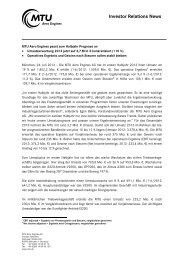
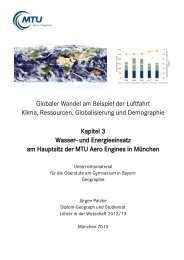
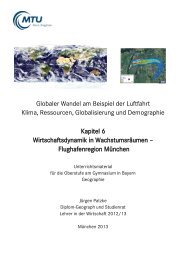
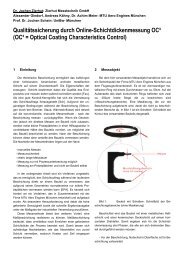
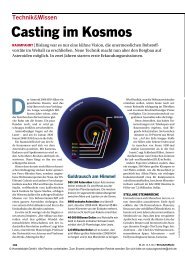


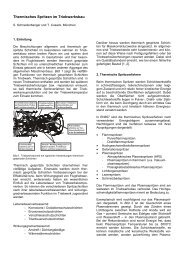
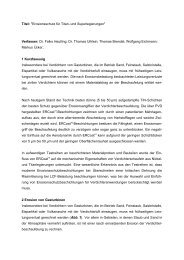


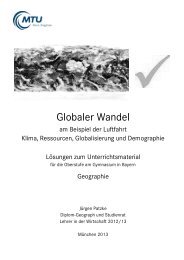
![Download PDF [5,37 MB] - MTU Aero Engines](https://img.yumpu.com/21945461/1/190x125/download-pdf-537-mb-mtu-aero-engines.jpg?quality=85)